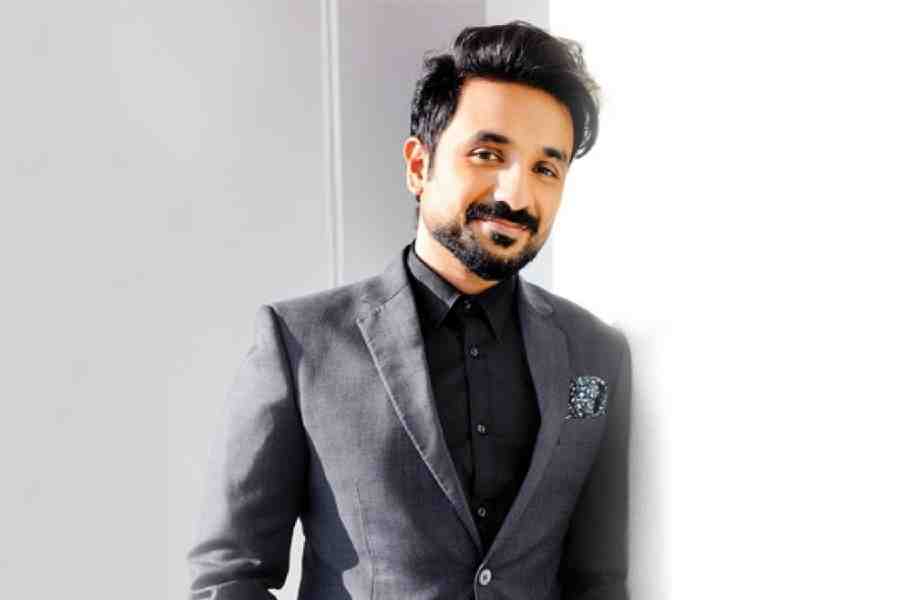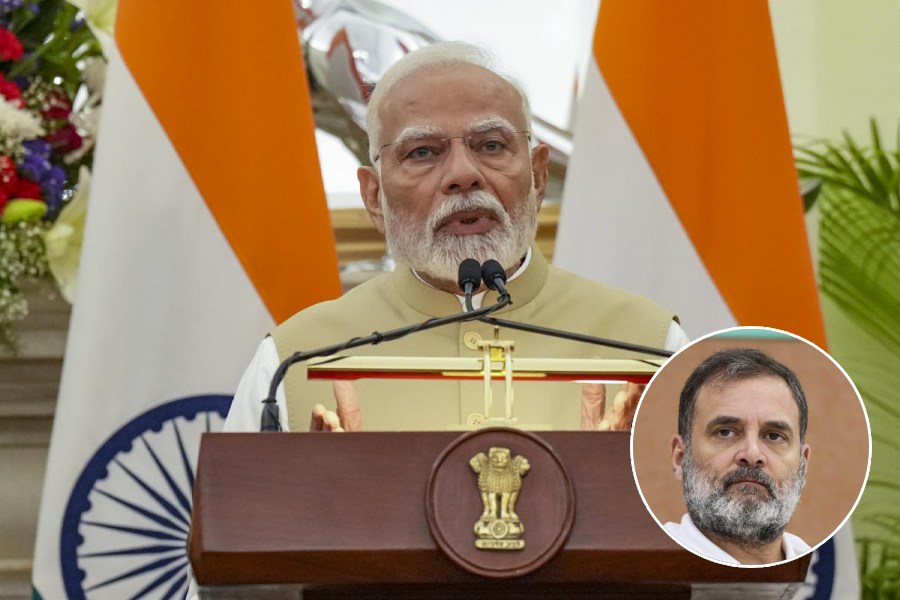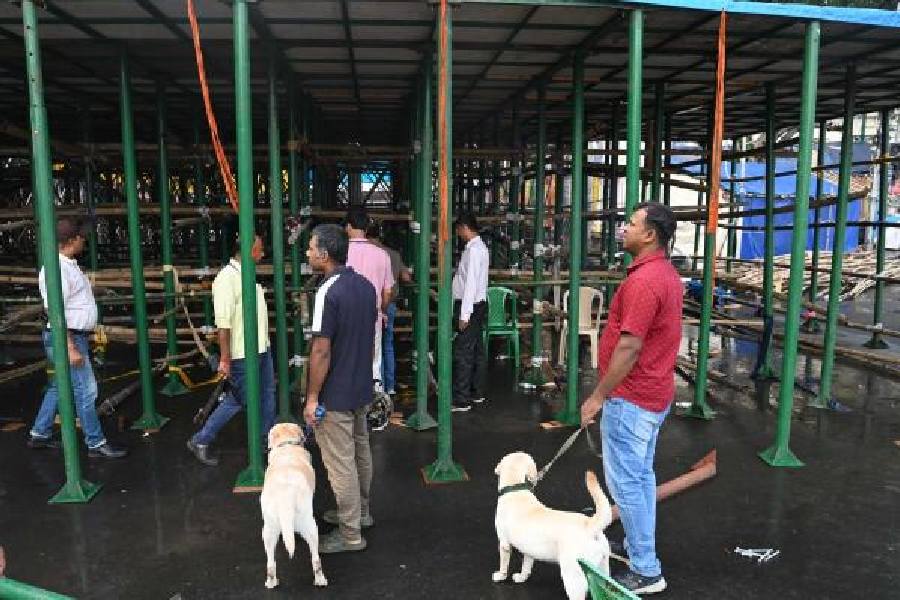 |
 |
 |
 |
| (From top): A model in an Anokhi outfit; models in Westside ethnicwear; a model in an Indo-Western outfit from W; shoppers check out the ethnic range at FabIndia |
A quiet retail revolution has been taking place in the Indian woman?s wardrobe. Not the Indian woman who walks into a designer showroom and gets herself fitted into a Rs 5,000 jewelled kurti, but the one who saunters into a mall, spies something she likes in a smart yet affordable store, and promptly sacks the local darzi whose idea of design innovation is changing the neckline of her kurta from square to round.
While Westernwear has been creeping into the consciousness of the young urban Indian woman ? especially after the cultural upheaval wrought by cable TV, India is still far from becoming a slave to Western fashion as its other south-east Asian cousins.
What?s hot is fusion fashion but the fusion is still heavily tilted towards Indian styles. In fact, demand for ethnicwear and Indo-Westernwear that chains like FabIndia and Anokhi started feeding decades back is now gaining momentum like never before. What these pioneers realised was that the Indian woman?s sense of dressing was aspirational, yet she didn?t want to change completely into Western modes of dressing. She wanted her clothes to reflect her new personality ? that of a savvy woman of the world ? yet not be in trouser suits all the time. Retaining her femininity was important, but not at the cost of looking dowdy or ? horror of horrors ? behenji-like.
?In Japan, China and Thailand, most women have almost completely abandoned their ethnic ways of dressing, reserving them for rare occasions,? says Rathi Vinay Jha, head of the Fashion Design Council of India (FDCI). ?But in India, the average woman on the street and even those who are fashion-conscious think nothing of wearing a churidar-kurta or a saree. The day they stop doing that will be a sad one for Indian fashion.?
So we have the handloom fabrics and the block-prints and the kurtas and the A-line skirts that are forever ethnic, forever in. The message from the pioneer retailers of fusion fashion is ?wear our clothes and you?ll be wearing something safe, something comfortable and something that?ll never go out of fashion?. There are certain guidelines: use natural fabrics, use Indian handloom and printing techniques but don?t go over-the-top with the traditional aspect. No heavy zari and zardosi work and no overtly ?Indian? effects such as a profusion of embroidery. The result is a success story in which ethnic Indian aesthetics have been married with a Western design sensibility.
That?s the credo most of the newer popular chains are following, too. Ethnicwear retailers such as W, Good Things and Khadder are opening stores at a fast and furious pace and the industry that is pegged at Rs 9,000 crore by a KSA-Images study is seeing an infusion of newer and fresher design inputs. Giving them competition are the in-house ethnicwear labels of giants such as Shoppers? Stop, Westside and Pantaloons.
Besides the multi-store chains, there are stand-alone stores in various metros such as Prapti in Calcutta, Shoma and Sadka in Delhi and Biba and Srishti in Bangalore that are also eyeing the prospect of expansion hungrily. And of course, the old staples ? FabIndia and Anokhi ? continue to expand eagerly.
The industry, according to one analysis, is steadily growing at around 35 per cent a year, a fact quite obvious when you look at any new retail space, such as a mall or a plaza, that has opened up in any of the metros recently. You?ll find one or more of the brands present there. Bangalore?s latest materialistic acquisition ? the 7,00,000 sq feet Garuda mall ? already boasts of W and FabIndia. And this is when FabIndia already has two outlets in the city and W one, opened just a couple of months back.
FabIndia, or plain Fab as it?s affectionately called, plans to open more than half a dozen new outlets in India this year. Among the new locations where it?s heading are Goa, Pondicherry, Noida, Mangalore, Hyderabad, Vizag and Baroda. ?We?re planning a second store in Chennai and are also considering another couple of stores in Mumbai. The market is just ripe,? says FabIndia representative Anjana Batra. Four-year-old Good Things, with stores in Noida, Gurgaon, Kaushambi, Mumbai, Thane and Bangalore, is opening two more in the National Capital Region within the next three months.
As for what?s making ethnicwear so popular with urban men and women, Batra has a gamut of reasons. ?Firstly, ethnic is in. The Indian woman is proud of her identity and happy to flaunt it. Design consciousness has made ethnicwear a fashion statement ? hemlines, necklines and colours follow global trends. It?s comfortable ? the churidar /salwar-kameez ensemble for example ? allows for easy mobility. And it?s in keeping with the local culture. Given the Indian textile heritage, ethnicwear offers variety that?s unmatched. Finally, by and large, ethnicwear is ?affordable? and hence frequently replaceable.?
According to Pritam Singh, managing director, Anokhi, ?The Indian population is unique in Asia for keeping its own strong sense of identity despite the cultural onslaught from the West, in food and films as well as clothing.?
| Ethnic staples for your wardrobe |
| • Hand-block printed short kurtas in vibrant colours • Mix-and-match churidar-kurta ensembles, with or without dupattas • Straight skirts in raw cotton with slits down the side • Long crinkled skirts with gota edges and khari work • White cotton or chanderi dupattas that go with everything |
Vijay K Mishra, CEO of the womenswear brand W from TCNS Clothing, shares their feelings. ?The womenswear market in India was always traditionally serviced. There was nothing for the modern Indian woman who was equally comfortable in jeans and capris as an ethnic churidar-kurta. That woman is our client ? the one who wants the right balance between tradition and modernity,? says Mishra. The fact that Indian clothing already had an ethnic alternative to the trouser-shirt attire in a trouser-like salwar and a shirt-like kurta could also have something to do with the eternal popularity of this silhouette, feels Mishra.
Since setting up business three years back, W has expanded beyond its wildest expectations. The chain now boasts 30 exclusive stores in locations such as Delhi, Noida, Gurgaon, Chandigarh, Ludhiana, Mumbai, Chennai, Hyderabad, Bangalore, Pune and Calcutta. W is also available at leading multi-brand stores like Shoppers Stop, Lifestyle, Globus and Pantaloon in major cities. Most recently it has just opened an outlet in Calcutta?s Salt Lake City, its third store within a year.
Not only that, the brand has now forayed into costume jewellery ? what they say is their first step toward ?providing complete grooming solutions to the modern Indian woman?. While most ethnicwear is casual and daytime wear, W is launching a line called Wishful, showcasing sheer drapes and embroidery in silk for party and occasionwear. The company also recently launched its Indo-Western line ? Western silhouettes with traditional Indian motifs and prints ? with a line of trousers, capris and wrap-around skirts.
Calcutta?s home grown ethnicwear brand, Khadder, promoted by city entrepreneurs Arup Datta and Rahul Upadhyay, has made inroads into the southern and northern Indian markets with stores in Bangalore, Pondicherry, Lucknow and Chandigarh. Returns have been good and response for Khadder?s brand of clothes ? khadi with a twist ? better than they?d expected. They?re soon opening large format stores in Mumbai, Delhi, Hyderabad and Chennai in 4,000-10,000 square feet size slots. ?The market is booming and totally ready for ethnicwear. We see a huge potential in this,? says Datta.
Giving the individual stores a run for their money are the department stores, which as a retail credo always have strong ethnic wear lines for both men and women under their roofs. Says Himanshu Chakrawarti, senior manager, public relations, Westside, ?Ethnicwear is extremely important to Westside?s scheme of things. It?s the single largest department in terms of sales at Westside and also growing at a scorching pace year on year.?
While the Western casual range is very popular at Westside, demand for the ethnicwear range is significantly higher. Chakrawarti feels this is due to the sheer size of the ethnicwear market, which is much larger than the Westernwear market.
The sheer proliferation of retail space has definitely contributed to the boom in this segment. With consumerism at a new high and new malls opening up in metros, the availability of retail space has encouraged many chains to open new branches. Also, as Mishra of W says, buyers mainly purchase when they see something that grabs them. ?The bulk of shopping from our kind of stores is on impulse. People go to malls, walk into our stores and see something they like, and they end up buying,? he says.
But even as these brands expand locally, they?re also raking in the riyals, pounds and dollars. FabIndia already has stores in Rome and Dubai. Anokhi, too, sells in several countries overseas under its own label, and also under different labels in England, Paris, Japan and Germany. The fledgling W is also excited about its global dreams which it plans to realise by placing the label in various stores in cities worldwide. It aims not only to cater to the Indian diaspora but to a Western clientele who want ready-to-wear with an Indian flavour.
After all, as the designers have been trying so long and hard to tell us, Indian is in.
It’s a man thing, too
Women form the primary target consumers of the ethnicwear stores and brands. But retailers are increasingly turning their attention to the urban Indian male who is not afraid to be seen in pink khadi kurtas. The long kurta has today become acceptable casual and semi-formalwear. In khadi or raw cotton with checks, stripes and in solid colours, the kurta does its duty at functions and is even acceptable Friday dressing. And a silk one — with or without embroidery — will do well for an evening party.
And as for the kurti or the kurta-shirt, Shah Rukh Khan’s wearing them in films like Chalte Chalte and Kal Ho Na Ho ensures its eternal popularity. Today, men wearing short kurtas inscribed with Oms and other religious motifs are as common a sight as men wearing stiff white shirts. Most of the ethnicwear brands also design shirts for men in cotton and raw silk and solid colours — a refreshing change from the sameness of the checks and stripes of branded shirts.
Photograph of Anokhi by Pabitra Das,
FabIndia store by Subhendu Chaki
FabIndia models: Nicola and Arijit
Location courtesy: FabIndia










